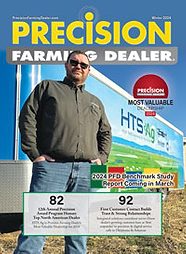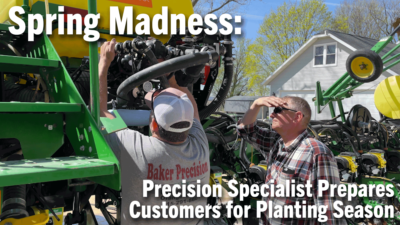Get an Understanding of the Position Before Placing Your First 'Help Wanted' Ad
|
Dawn Hillrud, B.Admin; CHRP
If you’re creating a new precision farming department, you should know that the process of recruiting employees has changed. This article, the second of four, will discuss that knowing and understanding the job is a critical platform for successful recruitment.
Step Two: Know the Job and Your Dealership
Before you can talk about the precision farming position that you are recruiting for (messaging/job ads), determine the best candidate (candidate evaluation and selection), show the new employee what to do and have clear expectations for the employee (orientation and performance management) — you better have a strong understanding of the job.
How do you gain this much-needed understanding of the job?
-
Think broadly and think forward — not just about what the last person who handled that line for you did. Think about what needs to be accomplished in the short and long-term. Consider what the job does now and what new tasks will be expected, as well as any growth that is needed in the job.
-
Consider the culture of the job and the organization — will the role be fast-paced and exciting? Or, will it be laid back and repetitive? Ensure that by reading the job messages, candidates can assess whether their preferred work style and personality will mesh with the job.
-
Talk to the people who are currently working in the position at your dealership — what do they feel are the best and worst aspects of the job? What do they feel are the most important objectives that a new employee must meet?
-
Define what sets the best person apart from the others — ask yourself what sets the overachieving employees in this position apart from the average ones in your workplace and define what they do differently.
- Think about performance — use timelines to communicate job expectations. What defines success in the job — after one month on the job, after three months, after six months, after a year? If objectives for the precision farming specialist at your dealership are communicated before the candidate is hired, the candidate will strive to meet these objectives very early in their career with you.
Messaging — Once you know the job inside and out, messages, including a realistic job preview, can be developed. A realistic job preview conveys job information to an applicant in an unbiased manner, thereby presenting all pertinent information in a straightforward, non-selling manner.
An example of what might be included in a realistic job preview for a position at a dealership is that planting and harvest are peak times and overtime may be required over those seasons. Without a realistic preview of both the good and challenging aspects of the job, a successful candidate may be surprised with some facets of the job, which could result in dissatisfaction and costly turnover.
Knowing the position will also allow you to touch on the most appealing aspects of the job in the job advertisements. Use these appealing aspects to catch the attention of people who might not otherwise look at a job ad or apply. For example, if you have a new machine shop and you are recruiting for an Agricultural Technician, use a catchy opening line on your ad such as: “Maximize your potential as a precision farming technician in a state of the art shop — use the latest technology as you work.”
A keen understanding of the job may also reveal aspects of the position or workplace that will help to “brand” your job and organization. Branding means pointing out what makes your organization and the job unique. It explains to potential candidates why they should come to work for you, rather than the competition.
Candidate Evaluation and Selection — Knowing the precision specialist’s position and the desired job outcomes makes choosing the right candidate less difficult. As you assess and interview candidates, you must know exactly what candidates need to be able to perform to be successful. It’s not always as simple as how long someone has worked in the electronics or agriculture industry. Do they have what it takes to achieve the requirements of the job at your dealership?
For example, you have two candidates for your new precision farming department. One has a lot of experience in agriculture but none in relationship building with customers/sales — while the other’s experience includes posting stellar sales in another industry. Often employers will default to the candidate with the most ag experience — regardless of whether or not that experience will transfer to sales. In a case like this, employers need to remind themselves that what is most important in a sales role is relationship building. During the interview can the candidate provide examples of when they have built relationships with customers and closed sales? If they have done it in one industry they will certainly be able to do it at a farm equipment dealership.
Simplifying Orientation and Performance Management — A strong understanding of the job simplifies orientation/employee training and performance management. Knowing the job objectives and how they will be measured makes orientation planning easier by defining the objectives that must be met by the employee. These objectives are also useful for those who are training the new employee by providing guidelines of where to take the employee in the training process. When both the dealership and the employee know the expectations around the objectives, these objectives become goals that are benchmarked for the employee’s first performance planning meetings.
Knowledge of the precision farming that you are recruiting for will empower you to make the most informed hiring decisions and will alleviate turnover and performance planning concerns.
Part one of this series was published in the January 19 issue of Precision Farming Dealer. To read it, click here: Understanding the Changes.







Post a comment
Report Abusive Comment